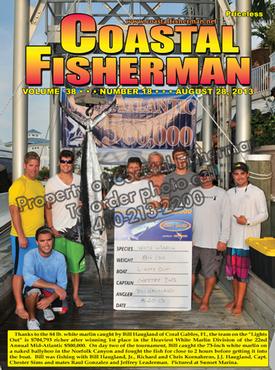


Article by Capt. Mark Sampson
 To some, the term “bobber” might conjure up impressions of a kid sitting by a pond with a cane pole, a can of worms and a red and white plastic ball floating above an earthworm squiggling on a rusty hook. So a bobber is something that a lot of “tough-guy” saltwater fishermen would never think to include in their arsenal of tackle used to capture monster fish. But change the name from “bobber” to “float” and suddenly the object in question has a better chance of being welcomed aboard even the most macho fisherman’s battlewagon. And that’s a good thing, because at one time or another, most fishermen will find a need to suspend a bait at a specific depth in the water column - exactly what floats are designed to do.
To some, the term “bobber” might conjure up impressions of a kid sitting by a pond with a cane pole, a can of worms and a red and white plastic ball floating above an earthworm squiggling on a rusty hook. So a bobber is something that a lot of “tough-guy” saltwater fishermen would never think to include in their arsenal of tackle used to capture monster fish. But change the name from “bobber” to “float” and suddenly the object in question has a better chance of being welcomed aboard even the most macho fisherman’s battlewagon. And that’s a good thing, because at one time or another, most fishermen will find a need to suspend a bait at a specific depth in the water column - exactly what floats are designed to do.
Fortunately for those who are worried about their image, these days bobbers, floats or whatever someone wishes to call them, come in enough of a variety of shapes, sizes and materials that no one needs to be concerned that they’ll be accused of using pond-fishing tackle out on the high seas. It’s just a matter of purchasing, or even making, the right float for the job that sometimes has anglers a little confused. Here are just a few ideas:
The 4-foot long pieces of colorful foam that kids play with in the water known as “pool-noodles” or “fun-noodles” can be crafted into effective floats for many types of fishing. Years ago we started using 10-inch lengths of fun-noodles as shark fishing floats and haven’t been without one on the boat ever since. To make a float, simply cut the noodle to the needed length, double wrap a rubber band around it, then pass the fishing line though the hole in the center of the float. After setting the bait to the desired depth a short loop of fishing line can be wrapped around the rubber band 2-4 times, and let the bait drift out from the boat, bridge or shoreline. When the fish is hooked and the line comes tight the line will pull out from the rubber band and the float will be free to slide up and down the line during the fight. Far superior to balloons as floats and a whole lot cheaper than buying the big and ridiculously expensive white Styrofoam floats, fun-noodles are certainly not limited to shark fishing and should be considered as an option for any type of fishing that requires a float, in fact 3-4 inch lengths are just right for tuna chunking.
Popping floats are typically Styrofoam floats tapered at the bottom with a concave top so that when the angler pulls sharply on the line the float will pop like a surface plug. The idea behind these floats is that the popping noise attracts fish to the bait suspended a few feet below it. These floats are used quite a bit in the South for redfish and speckled trout, but in this region they can also be effective for stripers, trout and bluefish. Popping floats (or any float for that matter) can also be used with jig type lures, allowing anglers to suspend a jig at a specific depth and away from the boat or shoreline.
Pencil or “cigar” floats are about 12-inches long and usually tapered at one or both ends and painted in bright colors for good visibility from a distance. The long tapering design gives them good buoyancy but prevents them from snatching too hard on the bait as waves pass. With a rubber band stopper tied to the line at a pre-determined distance above their bottom-rig, bridge and pier anglers are able to float their bait anywhere in the water column, including just a few inches off the bottom. Rt. 50 Bridge anglers often use these floats very effectively for flounder.
In a pinch, when a float is needed but none are available, anglers should use their imagination and employ whatever resources are available. I’ve made floats out of plastic sandwich bags, water bottles, koozie cup insulators, Styrofoam cups and once even cut up a perfectly good cooler into little squares to get the job done. And by the way, the classic little red and white plastic bobbers can be used to catch more than just bluegills on a pond. More than once I’ve successfully used them to catch big bluefin and yellowfin tuna back in the chunking years, so never underestimate the power of the bobber!
Captain Mark Sampson is an outdoor writer and captain of the charter boat “Fish Finder”, docked at the Ocean City Fishing Center.